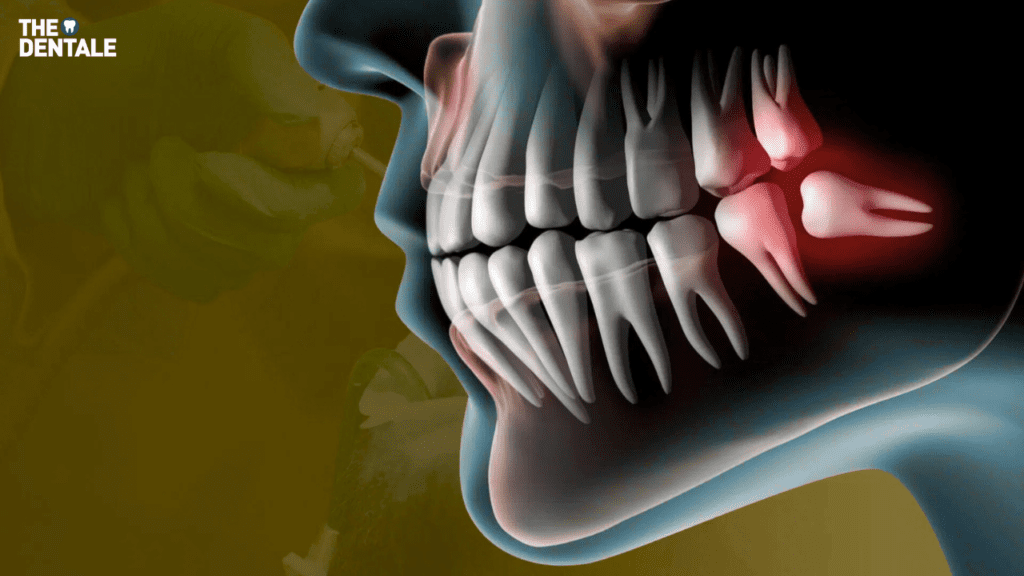
You’ve finally said goodbye to those stubborn wisdom teeth, so why does it feel like they’re making a comeback? Can wisdom teeth grow back after removal?
It’s a common concern, and understandably so! After all, who wants to go through that whole ordeal again?
Before you panic, let’s separate fact from fiction. In this article, we’ll uncover the truth about wisdom teeth regrowth. Read full article to find out if your wisdom teeth are staging a surprise return!
Myth: Can Wisdom Teeth Grow Back After Removal?
Let’s get one thing straight: once your wisdom teeth have been completely removed, they cannot grow back. It’s a myth!
Think of it like this: You can’t regrow a tree after you’ve chopped it down and removed the roots.
The Truth About Wisdom Teeth
Wisdom teeth, also known as third molars, are the last set of molars to develop in your mouth. They typically emerge in late adolescence or early adulthood.
However, they often cause problems because there’s simply not enough room for them in your jaw. This can lead to crowding, impaction, and other issues.
The Extraction Process
During a wisdom tooth extraction, an oral surgeon makes an incision in the gum tissue to expose the tooth and bone. They may need to remove some bone to access the tooth fully.
Once the tooth is loose, it’s carefully extracted from the socket. The area is then cleaned, and stitches may be placed to help the gums heal.
Regrowth: Fact or Fiction?
Although wisdom teeth cannot regrow, some post-extraction changes may create the illusion of regrowth:
- Incomplete Extraction: Tiny root fragments left behind can cause discomfort, irritation, or infection, making it feel like the tooth is returning.
- Bone Fragments: Small bone pieces may surface through the gums, feeling hard and sharp, similar to a tooth erupting.
- Soft Tissue Changes: As gums heal, shifts in tissue shape and pressure can create a sensation of something growing back.
Key Takeaways:
- Wisdom teeth cannot grow back once completely removed.
- Incomplete extractions, bone fragments, and soft tissue changes can sometimes mimic the feeling of regrowth.
- If you have any concerns about your wisdom teeth after removal, consult your dentist or oral surgeon.
Incomplete Extraction: Can Wisdom Teeth Fragments Be Left Behind?
While wisdom tooth extraction is typically thorough, small fragments of the tooth or root may sometimes remain. This is known as incomplete extraction, and it can lead to discomfort or delayed healing.
Why Does Incomplete Extraction Happen?
Several factors can contribute:
- Complex Tooth Position: Wisdom teeth may be deeply embedded or angled, making full removal difficult.
- Fragile Roots: Brittle roots can break during extraction, especially in older patients.
- Nerve Proximity: To prevent nerve damage, a surgeon may leave a tiny root fragment behind.
Signs of Incomplete Extraction
- Lingering Pain: Persistent discomfort at the extraction site.
- Infection Risk: Leftover fragments can harbor bacteria, leading to swelling or bad breath.
- Slow Healing: Prolonged soreness or delayed gum closure.
What to Do If You Suspect a Leftover Tooth Fragment
If you experience ongoing discomfort, consult your dentist or oral surgeon. Treatment options include:
- Monitoring: Small, non-problematic fragments may dissolve or remain harmless.
- Surgical Removal: If the fragment causes pain or infection, a minor procedure may be needed.
Phantom Sensations: Why It Feels Like Your Wisdom Teeth Are Growing Back
Okay, so we’ve established that wisdom teeth can’t actually sprout back up like rebellious weeds.
But what about that nagging feeling that something’s going on back there? Why does it sometimes feel like your wisdom teeth are staging a comeback?
Bone Fragments: The Tiny Troublemakers
During the healing process, tiny bone fragments can sometimes work their way up to the surface of your gums.
These fragments can feel hard and sharp, leading to the sensation that a tooth is erupting. Think of it like a tiny splinter making its way out of your skin, uncomfortable, but usually not a major issue.
Soft Tissue Regrowth: A Shifting Landscape
Your gums are dynamic and constantly changing. After wisdom tooth extraction, the gum tissue in the extraction site will regrow and remodel itself.
This process can sometimes create a feeling of fullness or pressure, leading to the perception that something is growing back there. It’s like your gums are rearranging the furniture a bit!
Sensory Changes: Nerves on High Alert
Nerves are the communication highways of your body, and they can be quite sensitive after surgery.
As the nerves in the extraction site regenerate, they can sometimes send out confusing signals, leading to unusual sensations like tingling, itching, or even the feeling of pressure. It’s like your nerves are still getting used to their new surroundings.
Key Takeaways:
- Even though wisdom teeth can’t grow back, you might experience sensations that mimic regrowth.
- These sensations are often caused by bone fragments, soft tissue regrowth, or nerve regeneration.
- If you have any concerns about unusual sensations after wisdom tooth removal, consult your dentist or oral surgeon.
Also Read: 50 Soft Foods to Eat After Tooth Extraction for a Fast & Painless Recovery
What to Expect After Wisdom Teeth Removal
So, you’ve waved goodbye to your wisdom teeth – congratulations! Now, what can you expect on the road to recovery?
While everyone’s healing journey is unique, here’s a general overview of the typical healing process and potential bumps you might encounter along the way.
The Healing Timeline: A Week-by-Week Guide
Days 1-3: The Initial Healing Phase
- Expect swelling, discomfort, and minor bleeding—this is normal.
- Use ice packs to reduce swelling.
- Stick to soft foods and avoid strenuous activities.
Days 3-7: Gradual Improvement
- Swelling and pain should start decreasing.
- Slowly introduce more solid foods as you feel comfortable.
- Maintain proper oral hygiene while avoiding direct brushing near the extraction site.
Week 2 and Beyond: Steady Progress
- Extraction sites will continue healing.
- Jaw function will gradually return to normal.
- Any residual discomfort should subside.
Potential Complications: Keeping an Eye Out
While most people recover smoothly, it’s important to be aware of potential complications:
- Dry Socket: Remember that protective blood clot? If it gets dislodged, you might experience dry socket, which can cause intense pain.
- Infection: Keep an eye out for signs of infection, such as increased pain, swelling, pus, or fever.
When to Call Your Dentist: Don’t Hesitate to Reach Out!
If you experience any of the following, don’t hesitate to contact your dentist or oral surgeon:
- Unbearable Pain: If the pain is severe or doesn’t improve with medication.
- Worsening Swelling: If the swelling increases after the first few days.
- Signs of Infection: Fever, pus, or increasing redness around the extraction site.
- Bleeding That Won’t Stop: If you experience prolonged or excessive bleeding.
Key Takeaways:
- The healing process after wisdom teeth removal is gradual and typically takes a couple of weeks.
- Be aware of potential complications like dry socket and infection.
- Don’t hesitate to contact your dentist or oral surgeon if you have any concerns.
Also Read: The Ultimate Guide to Dental Health and Hygiene: Say Goodbye to Dental Problems
Tips for a Smooth Wisdom Teeth Removal Recovery
Wisdom teeth removal is a significant procedure, and proper aftercare is essential for a smooth and comfortable recovery. Follow these key guidelines to minimize discomfort and avoid complications.
1. Choose a Skilled Oral Surgeon
A successful recovery starts with the right specialist. Select an experienced oral surgeon with a strong track record in wisdom teeth extractions. It is important to ask about their expertise, techniques, and success rates to ensure the best possible outcome.
2. Follow Post-Operative Instructions Carefully
Your oral surgeon will provide detailed aftercare guidelines designed to promote healing and reduce complications. Key recommendations typically include:
- Taking prescribed pain medication as directed
- Avoiding straws, smoking, or vigorous rinsing to prevent dry socket
- Limiting physical activity to allow the body to heal properly
3. Maintain Proper Oral Hygiene Without Disrupting Healing
Oral hygiene plays a crucial role in preventing infection and supporting recovery. Follow these steps:
- First 24 Hours: Avoid rinsing or brushing near the extraction site
- After 24 Hours: Use a saltwater rinse as instructed to reduce bacteria buildup
- Soft Brushing: Resume gentle brushing while avoiding direct contact with the extraction site
4. Eat a Soft, Nutrient-Rich Diet
A proper diet can aid the healing process and reduce irritation. Recommended foods include:
- Soft options: Yogurt, mashed potatoes, scrambled eggs, and applesauce
- Hydration: Drink plenty of water, but avoid using straws to prevent dislodging the blood clot
Key Takeaways:
- Choose an experienced oral surgeon for optimal results
- Follow post-operative care instructions to minimize complications
- Maintain proper but gentle oral hygiene to support healing
- Stick to a soft-food diet and stay hydrated to aid recovery
FAQ:
How rare is it for wisdom teeth to grow back?
It’s impossible for wisdom teeth to grow back once they’ve been completely removed. The sensation of regrowth is often due to other factors.
Why does it feel like my wisdom teeth are growing back?
“Regrowth” sensations are typically caused by:
Bone Fragments: Small bone pieces may surface during healing.
Soft Tissue Changes: Gum tissue remodels after extraction.
Nerve Sensations: Nerves may send unusual signals during healing.
Incomplete Extraction: In rare cases small portion of the tooth could remain.
Can teeth regrow after extraction?
No, teeth cannot regrow after a complete extraction. Once a tooth and its root are removed, they do not regenerate. However, sensations during healing can mimic regrowth.
Can wisdom teeth grow after 30?
Wisdom teeth typically emerge between ages 17 and 25. However, they can sometimes erupt later in life.
While it is less common for completely new wisdom teeth to emerge after age 30, it can happen. Also people can find that an impacted wisdom tooth that has never fully erupted, begins to cause issues after the age of thirty.
Conclusion:
- No Regrowth: Wisdom teeth can’t grow back once fully removed.
- Phantom Sensations: “Regrowth” feelings are usually caused by bone fragments, tissue changes, or nerve regeneration.
- Incomplete Extractions: Leftover fragments are possible but usually not a major issue.
- Choose an Experienced Surgeon: This minimizes complications.
- Follow Instructions: Adhere to post-op care guidelines.
- Stay Clean: Maintain good oral hygiene.
- Ask Questions: Contact your dentist if you have concerns.




